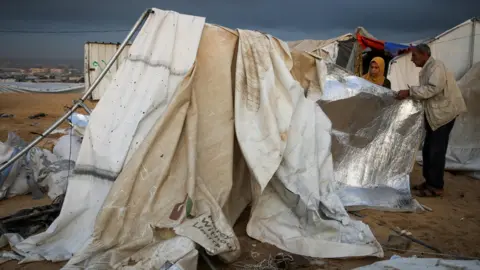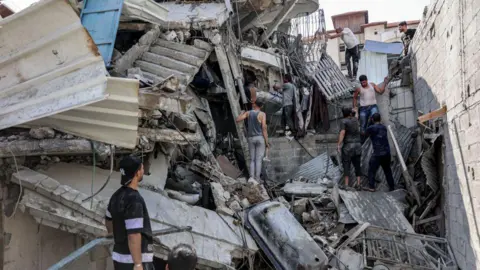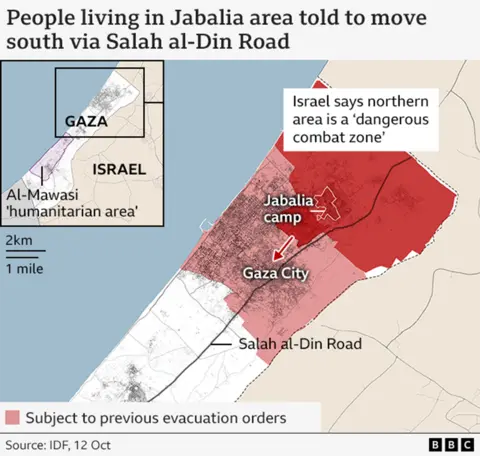The US gives Israel 30 days to improve aid to Gaza or reduce the risk of military support

 Reuters
ReutersThe United States has written to Israel, giving it 30 days to increase humanitarian access to Gaza or risk cutting off US military aid.
The letter, sent on Sunday, amounts to the strongest known written warning from the US to its allies and comes amid a new Israeli offensive in northern Gaza that has reportedly caused dozens of casualties.
It says the US is deeply concerned about the deteriorating humanitarian situation, adding that Israel has refused or blocked nearly 90% of humanitarian movements between the north and the south in the past month.
Israel is reviewing the letter, an Israeli official is reported to have said, adding that the country “takes this matter seriously” and intends to “address the concerns raised” with its US counterparts.
Israel has previously said it is targeting Hamas operatives in the north and is not blocking the entry of humanitarian aid.
On Monday, the Israeli army in charge of the crossing of people in Gaza, Cogat, said that 30 trucks carrying aid from the World Food Program entered northern Gaza through Erez.
That ended a two-week period in which the UN said no food aid had been delivered to the north, and the essentials for survival were running out for 400,000 Palestinians there.
A UN official said Gaza is in a “continuing state of emergency”.
Antoine Renard, the head of the World Food Program (WFP) in the occupied territories of Palestine, told AFP news that people in the north of the area “rely only on aid” for not being able to get fresh food other than what the UN provides. agencies.
The US is Israel’s biggest arms supplier, and the Israeli military has relied heavily on US-supplied aircraft, guided bombs, missiles and shells to fight the war against Hamas in Gaza over the past year.
The US letter to the Israeli government – the contents of which have now been confirmed by the state department – was first reported by the website Axios. It was signed by Secretary of State Antony Blinken and Secretary of Defense Lloyd Austin.
“We are now writing to emphasize the US government’s deep concern about the deteriorating humanitarian situation in Gaza, and to demand urgent and sustained action by your government this month to turn the tide,” he said.
It says Israeli evacuation orders have forced 1.7 million people into the narrow, coastal al-Mawasi area where they are “highly vulnerable to deadly infection” due to overcrowding, and that aid agencies report that their survival needs cannot be met.
“We are deeply concerned that the recent actions of the Israeli government – including halting exports, denying or preventing almost 90% of humanitarian movement between northern and southern Gaza in September, continuing excessive dual use restrictions, and imposing new and onerous inspections. Debt and cultural requirements in aid workers and shipments – as well as increasing lawlessness and looting – are contributing to the rapid deterioration of conditions in Gaza,” he adds.
The letter says Israel “must, from now and within 30 days” act on a series of concrete steps to improve aid resources, adding that failure “could have an impact on US policy”.
It cites US laws that would restrict military aid to countries that block the delivery of US humanitarian aid.
It says Israel must “use all forms of humanitarian aid throughout Gaza” before winter, including enabling at least 350 trucks a day to enter all four major crossings and a new fifth crossing, as well as allowing the people of al-Mawasi to enter . move to the country.
It also calls on Israel to end the “isolation of Northern Gaza” by reaffirming that “there will be no Israeli government policy of forced evacuation of civilians” from north to south.
At a press conference in Washington on Tuesday, US State Department spokesman Matthew Miller told reporters that the letter was “a private communication that we did not intend to disclose.”
“Secretary [Blinken] and Secretary Austin felt it necessary to make it clear to the Israeli government that there are changes they need to make and to see the level of aid to Gaza increase,” he said.
Mr Miller declined to speculate on what the consequences would be for Israel if it does not increase humanitarian access.
But he noted: “The recipients of US military aid do not arbitrarily deny or prevent the provision of aid to the US people. That is just the law and we will certainly follow the law. But our hope is that Israel will make the changes we have mentioned.”
He also said that the 30-day time limit has nothing to do with the upcoming American presidential election on November 5, and said that “it is necessary to give them time to fix different problems”.
Israel has previously insisted that there are no limits on the amount of aid or humanitarian aid that can be delivered to the rest of Gaza, and has accused UN agencies of failing to distribute resources. It also accused Hamas of stealing aid, which the group denies.
Before Israel’s attack on southern Gaza in the town of Rafah in May, President Joe Biden stopped a single shipment of 2,000 and 500lb bombs for the first time as he tried to stop it from an all-out attack.
But the president quickly faced backlash from Republicans in Washington and Israeli Prime Minister Benjamin Netanyahu, who appeared to compare it to an “arms embargo”. The suspension was partially lifted in July and has not been repeated.
 AFP
AFPEarlier on Tuesday, the International Committee of the Red Cross (ICRC) warned that families in northern Gaza “are facing unimaginable fear, loss of loved ones, confusion, and exhaustion” due to the Israeli offensive that began 10 days ago.
Israel’s military says it has sent tanks and troops back to the town of Jabalia and its urban refugee camp for the third time to eliminate Hamas fighters who have regrouped there.
It has ordered residents of Jabalia, as well as neighboring Beit Lahia and Beit Hanoun, to evacuate to the “al-Mawasi relief area”.
The UN says around 50,000 people have fled Gaza City and other parts of the north. But for many it is not safe to leave their homes or they cannot go out because they are sick or disabled.
Khalid, a resident of Jabalia whose accounts of the past year have been included in a new BBC documentaryhe said in a voice that made him and his family live in fear for a week.
“We were told to go south, but we couldn’t because the Israeli army surrounded the area, or used quadcopter drones. We can’t move, it’s very difficult.”
“At the same time, because of the intense bombing we are living in fear. My daughter is sick and has a fever. Her whole body is shaking from fear because of the sound of the bombing and I don’t know what to do with her, I can’t even take her to the hospital,” he said.
The Hamas-run Civil Defense in Gaza said first responders found the bodies of 42 people killed by Israeli airstrikes and gunfire in Jabalia and neighboring areas on Tuesday.
It is reported that they include 11 members of one family, almost all of whom are women and children, whose house was destroyed in an airstrike overnight.
The Israeli army said on Tuesday that its forces had killed “a large number of terrorists” in the Jabalia area in the previous day.
on monday, Israeli human rights groups have warned of what they call “alarming signs that the Israeli military is beginning to quietly implement the General Plan”echoing the widespread concern of Palestinians.
The controversial plan calls for the forcible transfer of all civilians to the north followed by a siege of the remaining Hamas forces there to force their surrender and the release of Israeli hostages.
The Israeli military denies it is being used, saying it is only to “remove civilians from danger”.
Israel launched a campaign to destroy Hamas following the group’s unprecedented attack in southern Israel on October 7, 2023, in which approximately 1,200 people were killed and 251 others were captured.
More than 42,340 people have been killed in Gaza since then, according to the health ministry run by Hamas in the area.

Source link




